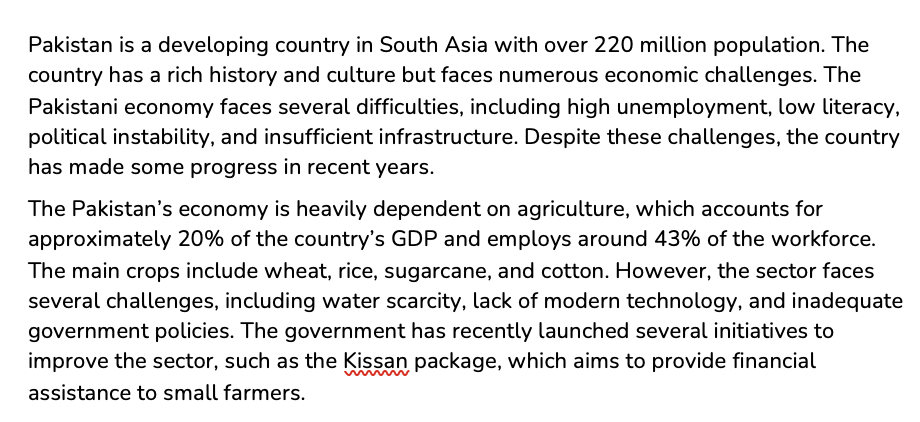An Overview of Pakistan Economy
Summary:
Pakistan, a developing country in South Asia with a population of over 220 million, grapples with numerous economic challenges such as high unemployment, low literacy rates, political instability, and inadequate infrastructure. Despite these hurdles, the country has shown some progress in recent years. The economy is segmented into agriculture, manufacturing, and services sectors, contributing approximately 20%, 25%, and 55% to the GDP, respectively. Agriculture employs around 43% of the workforce but faces issues like water scarcity and outdated technology. The government has initiated programs like the Kissan package to aid small farmers. The manufacturing sector, producing goods like textiles and cement, struggles with power outages and a lack of skilled labor. Initiatives like the National Industrial Policy aim to incentivize investment in this sector. The services sector, including banking and telecommunications, is the largest contributor to the GDP. The government is promoting this sector through initiatives like the Trade Development Authority of Pakistan. However, the economy still faces significant challenges, including high inflation, a large budget deficit, and a high debt-to-GDP ratio. Political instability further exacerbates these challenges, although projects like the China-Pakistan Economic Corridor aim to boost economic growth. In summary, while Pakistan has made some strides, particularly in the services and manufacturing sectors, much work remains to achieve sustained and inclusive economic growth.
Excerpt:
An Overview of Pakistan Economy
Pakistan is a developing country in South Asia with over 220 million population. The country has a rich history and culture but faces numerous economic challenges. The Pakistani economy faces several difficulties, including high unemployment, low literacy, political instability, and insufficient infrastructure. Despite these challenges, the country has made some progress in recent years.
The Pakistan’s economy is heavily dependent on agriculture, which accounts for approximately 20% of the country’s GDP and employs around 43% of the workforce. The main crops include wheat, rice, sugarcane, and cotton. However, the sector faces several challenges, including water scarcity, lack of modern technology, and inadequate government policies. The government has recently launched several initiatives to improve the sector, such as the Kissan package, which aims to provide financial assistance to small farmers.


Reviews